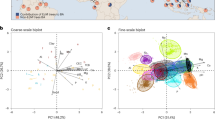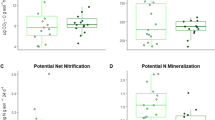Abstract
Soil fertility and associated nitrogen (N) status was a key ecosystem attribute, and surveys of ectomycorrhizal fungal (EMF) communities via epigeous fruiting bodies could provide an effective biotic indicator of forest soil productivity. We explored the utility of aboveground EMF communities in this regard by surveying sporocarps over a 3-year period from contrasting plant associations of southern old-growth boreal forests of British Columbia (Canada). Cumulative richness ranged from 39 to 89 EMF species per plot (0.15 ha) and followed a skewed parabolic correlation with foliar N concentrations and soil N availability. EMF species composition was consistently distinct in ordinations and strongly correlated to the increasing rates of N mineralization aligned with soil productivity. Approximately 40 EMF species were specialists, as they collectively indicated oligotrophic, mesotrophic, and eutrophic nutrient regimes, while the remaining species were categorized as broadly tolerant (distributed over 100% of the N gradient), partially intolerant (approximately 70%), or satellites (rare). The functional organization of EMF communities reflected by distribution classes could help define the ecological integrity of forests, which was characterized in this boreal landscape by an average allotment of 20 broadly tolerant, 25 partially intolerant, 15 specialist, and ten satellite species per plot. Epigeous fruiting bodies provided a disparate yet complementary view to the belowground assessment of EMF communities that was valuable in identifying indicators for ecosystem monitoring.





Similar content being viewed by others
References
Avis PG, McLaughlin DJ, Dentinger BC, Reich PB (2003) Long-term increase in nitrogen supply alters above- and below-ground ectomycorrhizal communities and increases the dominance of Russula spp. in a temperate oak savanna. New Phytol 160:239–253. doi:10.1046/j.1469-8137.2003.00865.x
Bessette AE, Roody WC, Bessette AR (2000) North American Boletes. A color guide to the fleshy pored mushrooms. Syracuse University Press, Syracuse, NY
Brandrud TE (1995) The effects of experimental nitrogen addition on the ectomycorrhizal fungus flora in an oligotrophic spruce forest at Gårdsjön, Sweden. For Ecol Manag 71:11–122
Brandrud TE, Lindstrom H, Marklund H, Melot J, Muskos S (1990) Cortinarius, Flora Photographica (English version). Cortinarius HB, Matfors
Breitenbach J, Kranzlin F (2000) Fungi of Switzerland (English version). Volumes 3–6. Translated by VL Waters and JF Waters. Mykologia, Lucerne
British Columbia Ectomycorrhizal Research Network (2007) Matchmaker: Mushrooms of the Pacific Northwest. Available from < http://www.pfc.cfs.nrcan.gc.ca/biodiversity /matchmaker/index_e.html> [updated January 30, 2007].
Cajsa MR, Nygren R, Eberhardt U, Karlsson M, Parrent JL, Lindahl BD, Taylor AFS (2008) Growth on nitrate and occurrence of nitrate reductase-encoding genes in a phylogenetically diverse range of ectomycorrhizal fungi. New Phytol 180:875–889. doi:10.1111/j.1469-8137.2008.02618.x
Dahlberg A, Jonsson L, Nylund J-E (1997) Species diversity and distribution of biomass above and below ground among ectomycorrhizal fungi in an old-growth Norway spruce forest in south Sweden. Can J Bot 75:1323–1335
Durall DM, Gamiet S, Simard SW, Kudrna L, Sakakibara SM (2006) Effects of clearcut logging and tree species composition on the diversity and community composition of epigeous fruit bodies formed by ectomycorrhizal fungi. Can J Bot 84:966–980. doi:10.1139/B06-045
Edwards IP, Cripliver JL, Gillespie AR, Johnsen KH, Scholler M, Turco RF (2004) Nitrogen availability alters macrofungal basidiomycete community structure in optimally fertilized loblolly pine forests. New Phytol 162:755–770. doi:10.1111/j.1469-8137.2004.01074.x
Erland S, Taylor AFS (2002) Diversity of ectomycorrhizal fungal communities in relation to the abiotic environment. In: van der Heijden MGA, Sanders IR (eds) Mycorrhizal ecology. Springer, Berlin, pp 163–200
Ferris R, Humphrey JW (1999) A review of potential biodiversity indicators for application in British forests. Forestry 72:313–328. doi:10.1093/forestry/72.4.313
Frego KA (2007) Bryophytes as potential indicators of forest integrity. For Ecol Manag 242:65–75
Gehring CA, Theimer TC, Whitham TG, Keim P (1998) Ectomycorrhizal fungal community structure of pinyon pines growing in two environmental extremes. Ecology 79:1562–1572
Gibson DJ, Ely JS, Collins SL (1999) The core-satellite species hypothesis provides a theoretical basis for Grime’s classification of dominant, subordinate, and transient species. J Ecol 87:1064–1067. doi:10.1046/j.1365-2745.1999.00424.x
Giesler R, Högberg M, Högberg P (1998) Soil chemistry and plants in Fennoscandian boreal forest as exemplified by a local gradient. Ecology 79:119–137
Grime JP (1998) Benefits of plant diversity to ecosystems: immediate, filter and founder effects. J Ecol 86:902–910. doi:10.1046/j.1365-2745.1998.00306.x
Hagerman SM, Sakakibara SM, Durall DM (2001) The potential for woody understory plants to provide refuge for ectomycorrhizal inoculum at an interior Douglas-fir forest after clear-cut logging. Can J Res 31:711–721. doi:10.1139/cjfr-31-4-711
Hamann A, Wang T (2006) Potential effects of climate change on ecosystem and tree species distribution in British Columbia. Ecology 87:2773–2786. doi:10.1890/0012-9658(2006)87[2773:PEOCCO]2.0.CO;2
Jonsson L, Dahlberg A, Brandrud T (2000) Spatiotemporal distribution of an ectomycorrhizal community in an oligotrophic Swedish Picea abies forest subjected to experimental nitrogen addition: above- and below-ground views. For Ecol Manag 132:143–156
Klinka K, Krajina VJ, Ceska A, Scagel AM (1989) Indicator plants of coastal British Columbia. University of British Columbia Press, Kelowna
Knoepp JD, Coleman DC, Crossley DA Jr, Clark JS (2000) Biological indices of site quality: an ecosystem case study of their use. For Ecol Manag 138:357–368. doi:10.1016/S0378-1127(00)00424-2
Kranabetter JM, Dawson CR, Dunn DE (2007) Indices of dissolved organic nitrogen, ammonium and nitrate across productivity gradients of boreal forests. Soil Biol Biochem 39:3147–3158. doi:10.1016/j.soilbio.2007.06.026
Kranabetter JM, Durall DM, MacKenzie WH (2009) Diversity and species distribution of ectomycorrhizal fungi along productivity gradients of a southern boreal forest. Mycorrhiza 19:99–111. doi:10.1007/s00572-008-0208-z
Kranabetter JM, Friesen J, Gamiet S, Kroeger P (2005) Ectomycorrhizal mushroom distribution by stand age in western hemlock-lodgepole pine forests of northwestern British Columbia. Can J Res 35:1527–1539. doi:10.1139/x05-095
Krebs CJ, Carrier P, Boutin S, Boonstra R, Hofer E (2008) Mushroom crops in relation to weather in the southwestern Yukon. Botany 86:1497–1502. doi:10.1139/B08-094
Kremsater L, Bunnell F, Huggard D, Dunsworth G (2003) Indicators to assess biological diversity: Weyerhaeuser’s coastal British Columbia forest project. For Chron 79:590–601
Lilleskov EA, Fahey TJ, Lovett GM (2001) Ectomycorrhizal fungal aboveground community change over an atmospheric nitrogen deposition gradient. Ecol Appl 11:397–410. doi:10.1890/1051-0761(2001)011[0397:EFACCO]2.0.CO;2
Luoma DL, Eberhart JL, Molina R, Amaranthus MP (2004) Response of ectomycorrhizal fungus sporocarp production to varying levels and patterns of green-tree retention. For Ecol Manag 202:337–354
McCune B, Grace JB (2002) Analysis of ecological communities. MjM Software Design, Gleneden Beach, OR
Mead R (1988) The design of experiments: statistical principles for practical application. Cambridge University Press, Cambridge
Moser M (1983) Keys to Agarics and Boleti (Polyporales, Boletales, Agaricales, Russulales). The Whitefriars, Tonbridge
Nilsson SG, Hedin J, Niklasson M (2001) Biodiversity and its assessment in boreal and nemoral forests. Scand J For Res Supp 3:10–26. doi:10.1080/028275801300090546
Nygren CMR, Edqvist J, Elfstrand M, Heller G, Taylor AFS (2007) Detection of extracellular protease activity in different species and genera of ectomycorrhizal fungi. Mycorrhiza 17:241–248. doi:10.1007/s00572-006-0100-7
O’Dell TE, Ammirati JF, Schreiner EG (1999) Species richness and abundance of ectomycorrhizal basidiomycete sporocarps on a moisture gradient in the Tsuga heterophylla zone. Can J Bot 77:1699–1711. doi:10.1139/cjb-77-12-1699
Perry DA, Amaranthus MP (1997) Disturbance, recovery and stability. In: Kohm KA, Franklin JF (eds) Creating a forestry for the 21st century: the science of ecosystem management. Island, Washington, DC, pp 31–56
Peter M, Ayer F, Egli S (2001a) Nitrogen addition in a Norway spruce stand altered macromycete sporocarp production and below-ground ectomycorrhizal species composition. New Phytol 149:311–325. doi:10.1046/j.1469-8137.2001.00030.x
Peter M, Ayer F, Egli S, Honegger R (2001b) Above- and below-ground community structure of ectomycorrhizal fungi in three Norway spruce (Picea abies) stands in Switzerland. Can J Bot 79:1134–1151. doi:10.1139/cjb-79-10-1134
Read DJ, Leake JR, Perez-Moreno J (2004) Mycorrhizal fungi as drivers of ecosystem processes in heathland and boreal forest biomes. Can J Bot 82:1243–1263. doi:10.1139/b04-123
Richard F, Moreau P-A, Selosse M-A, Gardes M (2004) Diversity and fruiting patterns of ectomycorrhizal and saprobic fungi in an old-growth Mediterranean forest dominated by Quercus ilex L. Can J Bot 82:1711–1729. doi:10.1139/b04-128
Richard F, Millot S, Gardes M, Selosse M-A (2005) Diversity and specificity of ectomycorrhizal fungi retrieved from an old-growth Mediterranean forest dominated by Quercus ilex. New Phytol 166:1011–1023. doi:10.1111/j.1469-8137.2005.01382.x
Robertson SJ, Tackaberry LE, Egger KN, Massicotte HB (2006) Ectomycorrhizal fungal communities of black spruce differ between wetland and upland forests. Can J Res 36:972–985. doi:10.1139/X06-001
Rűhling A, Tyler G (1990) Soil factors influencing the distribution of macrofungi in oak forests of southern Sweden. Hol Ecol 13:11–18
SAS Institute Inc (2004) SAS OnlineDoc® 9.1.3. SAS Institute, Cary, NC
Smith JE, Molina R, Huso MMP, Luoma DL, McKay D, Castellano MA, Lebel T, Valachovic Y (2002) Species richness, abundance, and composition of hypogeous and epigeous ectomycorrhizal fungal sporocarps in young, rotation-age, and old-growth stands of Douglas-fir (Pseudotsuga menziesii) in the Cascade Range of Oregon, U.S.A. Can J Bot 80:186–204. doi:10.1139/b02-003
Smith ME, Douhan GW, Rizzo DM (2007) Ectomycorrhizal community structure in a xeric Quercus woodland based on rDNA sequence analysis of sporocarps and pooled roots. New Phytol 174:847–863. doi:10.1111/j.1469-8137.2007.02040.x
Taylor AFS (2002) Fungal diversity in ectomycorrhizal communities: sampling effort and species detection. Plant Soil 244:19–28. doi:10.1023/A:1020279815472
Thiers HD (1982) Agaricales of California. Mad River, Eureka
Thompson ID (2006) Monitoring of biodiversity indicators in boreal forests: a need for improved focus. Environ Monit Assess 121:263–273. doi:10.1007/s10661-005-9119-z
Toljander JF, Eberhardt U, Toljander YK, Paul LR, Taylor AFS (2006) Species composition of an ectomycorrhizal fungal community along a local nutrient gradient in a boreal forest. New Phytol 170:873–884. doi:10.1111/j.1469-8137.2006.01718.x
Trudell SA, Edmonds RL (2004) Macrofungus communities correlate with moisture and nitrogen abundance in two old-growth conifer forests, Olympic National Park, Washington, USA. Can J Bot 82:781–800. doi:10.1139/b04-057
Tylutki EE (1987) Mushrooms of Idaho and the Pacific Northwest. Non-gilled hymenomycetes, vol 2. University of Idaho Press, Moscow, ID
Whittaker RH (1975) Communities and ecosystems, 2nd edn. MacMillan, New York, NY
Acknowledgments
Many thanks to Michelle Seidl for traveling to Smithers to work with the two lead authors on Cortinarius taxonomy. We also thank Sabina Copley and Marcel Lavigne for providing logistical support in vehicles and accommodation in undertaking the sporocarp surveys. Emma Harrower and Adam Cappuchino undertook the ITS analysis of Cortinarius vouchers at UBC Vancouver under the direction of Mary Berbee. Michaela Byrne of UBC Okanagan undertook the ITS analysis of the other fungal genera under the direction of Dan Durall. Will MacKenzie provided the nonmetric multidimensional scaling analysis, while Peter Ott and Wendy Bergerud were consulted on the statistical analysis. Clive Dawson and Dave Dunn of the B.C. Ministry of Forests Analytical Laboratory undertook the soil N and foliar chemical analysis. Funds for the research project were provided by the Forest Investment Account of British Columbia.
Author information
Authors and Affiliations
Corresponding author
Appendix
Appendix
Rights and permissions
About this article
Cite this article
Kranabetter, J.M., Friesen, J., Gamiet, S. et al. Epigeous fruiting bodies of ectomycorrhizal fungi as indicators of soil fertility and associated nitrogen status of boreal forests. Mycorrhiza 19, 535–548 (2009). https://doi.org/10.1007/s00572-009-0255-0
Received:
Accepted:
Published:
Issue Date:
DOI: https://doi.org/10.1007/s00572-009-0255-0




